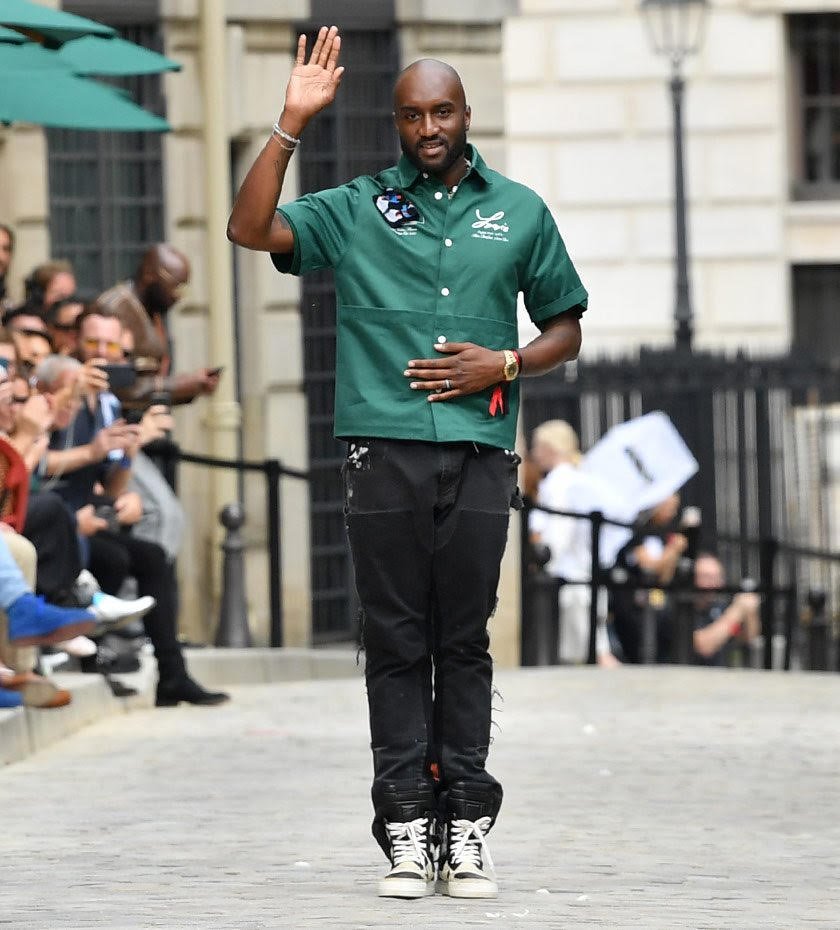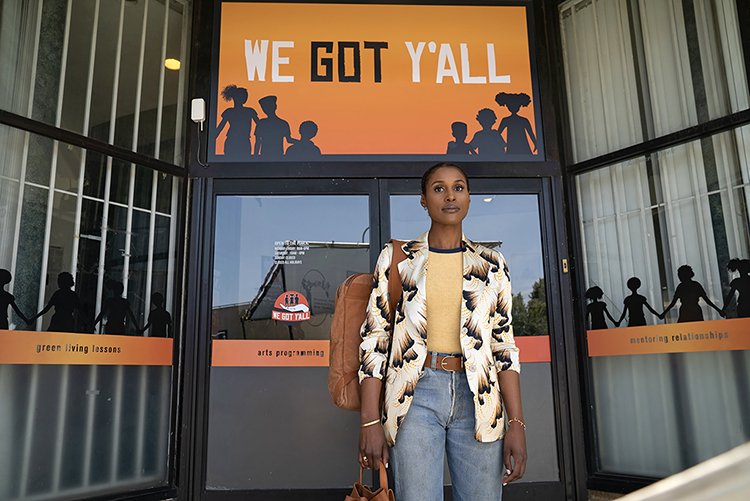Mentorship - The Vital and Intangible Currency of Black Creatives
by Jacob Nadir
Hugh A. Robertson (right) mentoring in Trinidad
In the midst of residual feelings following Virgil Abloh’s passing at the young age of 41, I considered the impact that Black leaders within various institutions have on the perceptions of those outside those institutions wanting to get in.
Does an institution suddenly seem more accessible when the head is Black? Is this feeling of sudden accessibility only felt by Black folks, or is it more universal? If it is more universal, what does that say about public sentiments towards Black leadership? Also, is the relatability of a leader just as valuable as their proficiency in the field they occupy?
Virgil Abloh demonstrated by example on how to execute visions that required the machine power only possessed by giants like Nike and Louis Vuitton. Because of Virgil’s emergence and commitment to his vision, that scope of production was made visible and attainable to creatives that once existed on the fringes. He was always objectively authentic to his values derived from the hodgepodge of counter cultures of his adolescence. He lifted as he climbed, reached back as moved forward, giving further momentum to the Sankofa tradition of his Ghanaian roots. I came across an Instagram post by Costume Designer Charlese Antionette (Judas and the Black Messiah) with an excerpt from an interview Virgil had with Pharrell and KAWS on OTHERtone. The most poignant excerpt came during this exchange:
Pharrell: When you realize how it really works, you stop buying vehicles to drive, and you create vehicles to drive you.
Virgil: Those are bars
…
Virgil: I was having a conversation with Reggieknow, he’s like a legend from where I’m from. From Chicago. He was one of the first people to wear Polo head to toe. In our community, that blew our minds. At the time he said he was not fortunate to afford fashion, he was just wearing track suits and stuff to high school. One day his brain sparked, and he was like “As a young black kid, the most advanced thing I can ever do - and this kinda ties up to (an earlier conversation in the interview about buying expensive cars) - like us as young Black kids trying to figure out how we can put ourselves in a different space so we can think at our biggest impact. And he was like “I’m gonna wear Polo head to toe. Fragrance, socks…”. And he was like “to be a Black kid in dreads who people thought I was from the hood, they guess my level of intellect - to be wearing head to toe Polo…”. So he’s a mentor of mine. I was on a Zoom with him in the (Louis Vuitton) office and I was like “It’s a little bit of a stretch but what I believe in is that now we’re in a place to almost do graffiti inside a building and have it broadcasted outward, rather than running around the city painting on buildings. He’s very well known for his illustrations and graffiti sketch style… He’s a multi-disciplinary since day one. But that bar of - we’re now inside companies, with access to do graffiti inside the walls. So it’s like I’m painting and that means this reference, or this logo, or this way of design that I’m able to do at Louis Vuitton speaks generationally to all the forefathers that came before me to make this brand what it is so that I can create in this space. And that’s just a metaphor across the board for how I see it.
…
Virgil: To me, there’s one level of the work that is designing at Louis. But my real job is to make sure that there’s like six young Black kids that take my job after me.
Virgil Abloh (via quint-shop.com)
The symbiotic relationships Virgil fostered are simply ripple effects of the relationships that inspired him. Many of us wondered just how many Black creatives he was directly impacting and we often criticized how white his staffs were, but still, he demonstrated a commitment to the cycle of receiving and giving inspiration. An abundant amount of those that caught the inspiration he provided are young Black creatives. Virgil’s commitment to the cycle of inspiration not only fueled his trajectory, but also planted several seeds for future industry leaders that now have more guidance on how to surpass the accomplishments Virgil acquired in his 41 years of life.
Within the Black tradition of filmmaking, mentorship and preparing the next generation of artists and technicians has always been a necessity. How else could a Black presence take up any kind of space in an environment powered by old money and old ideas? Whether this mentorship took place in the traditional studio system, or within independent frameworks - to be marginalized in the ecosystem of professional image making, is to have a constant state of urgency. The understanding of the power that images have on the masses, the de facto “one at a time” hiring practices, and the lack of initiative by the studios to fund Black projects paired with their funding of hateful and harmful images - fuels this urgency. We see this urgency manifest in ways such as: filmmakers creating high volumes of work independently (think Oscar Micheaux, Tyler Perry), filmmakers injecting a high volume of ideas into projects (think Melvin Van Peebles, Spike Lee), as well as the widespread and sustained practice of mentorship.
When a titan like John Singleton keeps an office in South Central at the peak of his career, that sends a message to emerging creatives nearby that your goals are more within reach than you may have originally thought. The accessibility of a John Singleton directly translates into a shift of the mindset in the surrounding creative economy. Creatives grant themselves permission to pursue grander endeavors just off the strength of “Look, Singleton did it and his office is right there.” This is the power of the 40 Acres office being in Fort Greene, Debbie Allen’s presence in Baldwin Hills, The Barbara Morrison Performing Arts Center being in Leimert Park, The Marathon Store being on Crenshaw and Slauson, Issa Rae’s Hilltop coffee shop being in the heart of Inglewood. In the cyclical practice of creatives uplifting emerging creatives, inspiration serves as a form of currency. The creative role demands an understanding of self as well as an awareness of one’s location within the larger sphere, so mentorship in these dynamics functions in the form of a demonstration more than anything else.
John Singleton in South Central, Los Angeles
Issa Rae on-set in Inglewood, Los Angeles (photo copyright of Merie W. Wallace - HBO)
The application of mentorship between creatives tends to be less formal than it is between technicians because the act of mentoring in the case of technicians is more of a direct instructor/student relationship. A great microcosm for the mentorship role among technicians can be encapsulated by a lineage of Black film editors who each took turns as mentors and mentees. Hugh A. Robertson (Brooklyn) paved the way for Black editors in the industry, and provided the first industry opportunity for filmmaker George Bowers (Bronx), who then took filmmaker Sam Pollard (Harlem) under his wing for a period. These three men from three historic boroughs, show us the value of taking time out to inform and foster new talent while simultaneously charting your own path. We see that the impact of mentorship is infectious - that if you are someone who benefits from mentorship, chances are high that you will become a mentor as well.
Hugh A. Robertson got into the Motion Picture Film Editors Union in 1960 after trying to get in for eleven years. In 1972, he told the LA Times “The old (union) regime finally got voted out and I got in.” After getting into the union, Robertson goes on to have a consistent presence in the industry as a working editor and eventually wins a BAFTA Award for Best Editing, along with an Academy Award nomination for Best Editing for his work in Midnight Cowboy (1969). His Academy Award nomination made him the first Black editor to be nominated. He then goes on to edit the classic Gordon Parks film Shaft (1971) before directing Melinda (1972). Soon after this run, he relocates to Trinidad & Tobago where he established and worked at a film and recording center called Sharc Productions with his wife Suzanne for ten years. He directed two features titled Bim (1974) and Obeah (1987) during his time in Trinidad & Tobago.
trailblazer Hugh A. Robertson
poster for Hugh Robertson’s film “BIM” (1974)
Very early in Robertson’s career he mentored a young man named George Bowers, who was fresh out of high school, and assisted Bowers in securing an assistant editor position at ABC. Bowers served a three-year tour with the Army and returned to work at Byro Productions, a company started by Hugh A. Robertson. It’s here that Bowers meets his wife Irene Brun, and works on TV pieces for Samuel Goldwyn Jr. and Jesse Jackson’s Operation PUSH.
editor/filmmaker George Bowers, grossly underrated in the annals of film history
Bowers then sustained a career of forty-plus years, consisting of about thirty editing credits, as well as seven directing credits. Some of his editing credits include Harlem Nights (1989), Sleeping With The Enemy (1991), and Roll Bounce (2005). He edited a handful of Penny Marshall’s directorial works including A League of Their Own (1992), Renaissance Man (1994), and The Preacher’s Wife (1996). He also directed Johnny Depp in one of his first roles ever in the sleazy teen comedy Private Resort (1985). But more important than any credit, is that he spent a period of his career serving as a mentor to his assistant, a young filmmaker named Sam Pollard.
Sam Pollard’s career is accurately regarded as “quietly monumental” in a January 2021 NY Times piece following the release of his documentary MLK/FBI (2021). He worked with Victor Kanefsky on the monumental film Ganja and Hess (1973) and then edited the immensely culturally significant documentary Style Wars (1983). He maintained a presence in the documentary world until pivoting into narrative editing for the bulk of Spike Lee’s 1990’s run. Mo’ Better Blues (1990), Jungle Fever (1991), Clockers (1995), Girl 6 (1996), 4 Little Girls (1997), and Bamboozled (2000) are all edited by Pollard. Not to mention that he edited Juice (1992) during this time as well.
modern day filmmaking legend Sam Pollard
He always maintained a presence in projects with material containing undeniable gravitas, editing and directing documentaries with a wide range of subject matter including but not limited to: gerrymandering, election integrity, Shirley Chisholm, Venus and Serena Williams, Frank Sinatra, Sammy Davis Jr., August Wilson, Zora Neal Hurston, and Marvin Gaye. He also directed two episodes of the HBO documentary series Atlanta’s Missing and Murdered: The Lost Children (2020), before directing his most recent works MLK/FBI, Black Art: In the Absence of Light (2021), and Mr. SOUL! (2021).
Pollard with one of his most famous collaborators, Spike Lee
Even if one’s journey is defined by a lack of mentorship, the allure of initiating that cycle remains. Mentorship as a practice is fluid and inherently infectious - whether it be as abstract of an impact as the one Reggieknow had on Virgil Abloh, or as fundamentally instructive as the relationship between Hugh A. Robertson, George Bowers, and Sam Pollard. The approaches and outcomes are limitless, and it is the vital and intangible advantage that Black creatives have in an environment where money and connections often outweigh the art itself. Just like the tradition of oral histories, mentorship is an invisible bond that should be above influences from factors like money and ego. The purpose of the mentorship relationship is to get better - to foster an individual’s development via the sharing of accumulated knowledge, resources, and access to relevant institutions.









